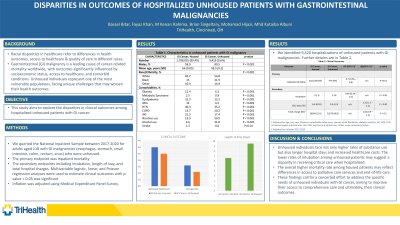Tuesday Poster Session
Category: Practice Management
P4909 - Disparities in Outcomes of Hospitalized Unhoused Patients with Gastrointestinal Malignancy
Tuesday, October 29, 2024
10:30 AM - 4:00 PM ET
Location: Exhibit Hall E

Has Audio
- BB
Bassel Bitar, MD
TriHealth Good Samaritan Hospital
Cincinnati, OH
Presenting Author(s)
Fayaz Khan, MBBS, MD, M Kenan Rahima, MD, Brian Singeltary, MD, Bassel Bitar, MD, Mohamad Hijazi, MD, Mhd Kutaiba Albuni, MD
TriHealth Good Samaritan Hospital, Cincinnati, OH
Introduction: Gastrointestinal (GI) malignancy is a leading cause of cancer-related mortality worldwide, with outcomes significantly influenced by socioeconomic status, access to healthcare, and comorbid conditions. Unhoused individuals represent one of the most vulnerable populations, facing unique challenges that may worsen their health outcomes. This study aims to explore the disparities in clinical outcomes among hospitalized unhoused patients with GI cancer.
Methods: This study identified all hospitalized adults aged ≥18 with GI malignancies (esophagus, stomach, small intestine, colon, rectum, anus) in the 2017-2020 National Inpatient Sample. The primary endpoint was inpatient mortality, with secondary endpoints including intubation, length of stay, and total hospital charges. Multivariable logistic regression analysis was utilized to estimate clinical outcomes, with a significance threshold of P< 0.05.
Results: The analysis included 1,717,455 hospitalizations for GI cancer, with 9,420 (0.5%) unhoused patients. Significantly higher unhoused patients were male (80.5%) and younger (58.5) compared to their housed counterparts (58.9% male, age 66). The racial composition in the unhoused population had higher Black (21.9% vs 13%) and Asian (14.9% vs 10.9%) individuals compared to housed counterparts. Unhoused exhibited higher rates of nicotine and alcohol use. Unhoused had less obesity, metabolic syndrome, and dyslipidemia compared to housed. However, they had a higher prevalence of GI bleed and chronic obstructive pulmonary disease. Unhoused had higher Medicaid and uninsured insurance status compared to housed. Unhoused patients experienced longer hospital stays and incurred higher total charges than housed. The rates of intubation were lower in unhoused. Interestingly, a lower rate of in-hospital mortality was observed in unhoused patients compared to housed patients.
Discussion: Unhoused individuals face not only higher rates of substance use but also longer hospital stays and increased healthcare costs. The lower rates of intubation among unhoused patients may suggest a disparity in receiving critical care when hospitalized. However, the overall higher mortality rate among housed patients may reflect differences in access to palliative care services and end-of-life care. These findings call for a concerted effort to address the specific needs of unhoused individuals with GI cancer, aiming to improve their access to comprehensive care and ultimately, their clinical outcomes.
Note: The table for this abstract can be viewed in the ePoster Gallery section of the ACG 2024 ePoster Site or in The American Journal of Gastroenterology's abstract supplement issue, both of which will be available starting October 27, 2024.
Disclosures:
Fayaz Khan, MBBS, MD, M Kenan Rahima, MD, Brian Singeltary, MD, Bassel Bitar, MD, Mohamad Hijazi, MD, Mhd Kutaiba Albuni, MD. P4909 - Disparities in Outcomes of Hospitalized Unhoused Patients with Gastrointestinal Malignancy, ACG 2024 Annual Scientific Meeting Abstracts. Philadelphia, PA: American College of Gastroenterology.
TriHealth Good Samaritan Hospital, Cincinnati, OH
Introduction: Gastrointestinal (GI) malignancy is a leading cause of cancer-related mortality worldwide, with outcomes significantly influenced by socioeconomic status, access to healthcare, and comorbid conditions. Unhoused individuals represent one of the most vulnerable populations, facing unique challenges that may worsen their health outcomes. This study aims to explore the disparities in clinical outcomes among hospitalized unhoused patients with GI cancer.
Methods: This study identified all hospitalized adults aged ≥18 with GI malignancies (esophagus, stomach, small intestine, colon, rectum, anus) in the 2017-2020 National Inpatient Sample. The primary endpoint was inpatient mortality, with secondary endpoints including intubation, length of stay, and total hospital charges. Multivariable logistic regression analysis was utilized to estimate clinical outcomes, with a significance threshold of P< 0.05.
Results: The analysis included 1,717,455 hospitalizations for GI cancer, with 9,420 (0.5%) unhoused patients. Significantly higher unhoused patients were male (80.5%) and younger (58.5) compared to their housed counterparts (58.9% male, age 66). The racial composition in the unhoused population had higher Black (21.9% vs 13%) and Asian (14.9% vs 10.9%) individuals compared to housed counterparts. Unhoused exhibited higher rates of nicotine and alcohol use. Unhoused had less obesity, metabolic syndrome, and dyslipidemia compared to housed. However, they had a higher prevalence of GI bleed and chronic obstructive pulmonary disease. Unhoused had higher Medicaid and uninsured insurance status compared to housed. Unhoused patients experienced longer hospital stays and incurred higher total charges than housed. The rates of intubation were lower in unhoused. Interestingly, a lower rate of in-hospital mortality was observed in unhoused patients compared to housed patients.
Discussion: Unhoused individuals face not only higher rates of substance use but also longer hospital stays and increased healthcare costs. The lower rates of intubation among unhoused patients may suggest a disparity in receiving critical care when hospitalized. However, the overall higher mortality rate among housed patients may reflect differences in access to palliative care services and end-of-life care. These findings call for a concerted effort to address the specific needs of unhoused individuals with GI cancer, aiming to improve their access to comprehensive care and ultimately, their clinical outcomes.
Note: The table for this abstract can be viewed in the ePoster Gallery section of the ACG 2024 ePoster Site or in The American Journal of Gastroenterology's abstract supplement issue, both of which will be available starting October 27, 2024.
Disclosures:
Fayaz Khan indicated no relevant financial relationships.
M Kenan Rahima indicated no relevant financial relationships.
Brian Singeltary indicated no relevant financial relationships.
Bassel Bitar indicated no relevant financial relationships.
Mohamad Hijazi indicated no relevant financial relationships.
Mhd Kutaiba Albuni indicated no relevant financial relationships.
Fayaz Khan, MBBS, MD, M Kenan Rahima, MD, Brian Singeltary, MD, Bassel Bitar, MD, Mohamad Hijazi, MD, Mhd Kutaiba Albuni, MD. P4909 - Disparities in Outcomes of Hospitalized Unhoused Patients with Gastrointestinal Malignancy, ACG 2024 Annual Scientific Meeting Abstracts. Philadelphia, PA: American College of Gastroenterology.

